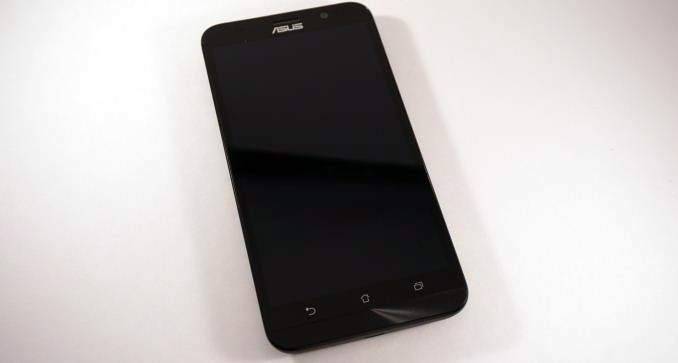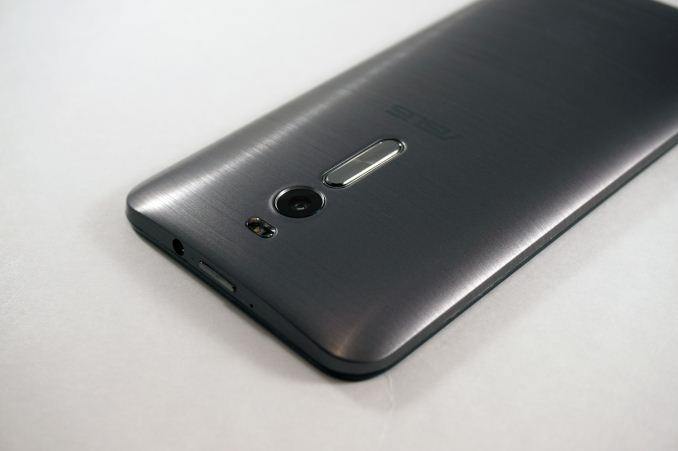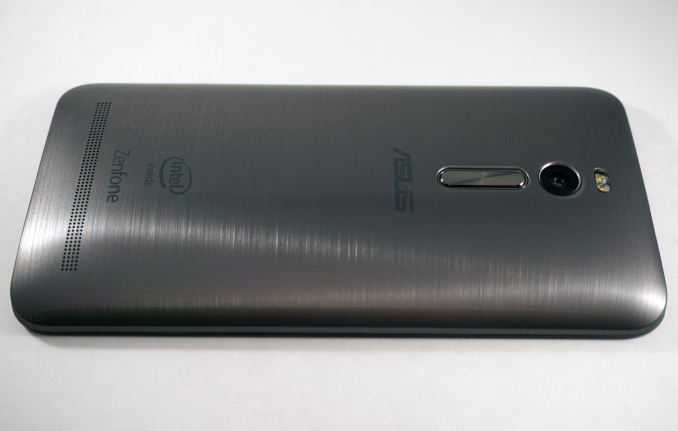The ASUS ZenFone 2 Preview
by Brandon Chester on May 18, 2015 2:00 PM EST
ASUS is not new to the smartphone market. Since the days of Windows Mobile (not the new Windows Mobile) they've been selling smartphones. But when it comes to Android devices they've been primarily focused on tablets. ASUS worked with Google to design and manufacture both generations of the Nexus 7, which was beloved by Android enthusiasts. Their PadFone devices were an attempt to have a smartphone that attached to a tablet shell to make a sort of 2-in-1 smartphone and tablet.
However it's only recently that the company has started making a serious push into what has become the traditional Android smartphone space. In 2014 the company had a fairly successful year in the smartphone space with their first generation of ZenFones, however while APAC sales were good they didn't quite make as big of a dent in the North American market as they could have - and likely not as big as they were hoping, I suspect.
This brings us to today with the North American launch of the ZenFone 2, the second generation ZenFone, and ASUS's second shot at making a major wave in the North American smartphone market. After initially going on sale in ASUS's home country of Taiwan on March 8th, and more recently in Japan and India, today ASUS is bringing over their latest phone to North America, where it will go on sale as an unlocked device through retailers like Amazon and Newegg.
It's hard to say which previous ASUS device the ZenFone 2 is a sequel to. It's actually a bit of an outlier compared to ASUS's earlier Android phones. Starting with the 2015 generation of ZenFones, ASUS has clamped down on the number of models they have released, ditching their broad spectrum of ZenFones in many sizes for fewer, more distinct models. As a result the last-generation ZenFones, the ZenFone 4, the ZenFone 5, and the ZenFone 6, have all been replaced with a single product, the ZenFone 2. The naming is a bit unfortunate in light of ASUS's earlier, sized-based naming scheme, but ultimately the point to take away from all of this is that what we're looking at is the second generation ZenFone. On a generational basis then, it's probably most accurate to call it a successor to the ZenFone 5, as it's similar in screen size and the ZenFone 2 is a natural progression when it comes to specifications.
In North America the ZenFone 2 is the first of ASUS's 2015 ZenFone products to launch, and it is the company's flagship smartphone for 2015. You won't see the budget ZenFone C here, and meanwhile the only other member of the ZenFone family will be the forthcoming ZenFone Zoom. As opposed to being another smartphone, the Zoom will be ASUS's take on a true cameraphone, combining a more complex point & shoot optics system - complete with optical zoom - with a traditional smartphone.
As for today's product launch, much like its 2014 predecessors, ASUS is coming out swinging with very aggressive pricing on the ZenFone 2. With the entry level model coming out at $199 and the most expensive model at $299, at first glance it seems strange to call the ZenFone 2 ASUS's flagship smartphone. At these prices the immediate competition for the ZenFone 2 would appear to be devices like the Moto G and the Lumia 735. But don't let yourself be deceived by the price. The ZenFone 2 has some extremely impressive specifications for a low cost smartphone, launching with a fairly powerful Intel quad-core Atom SoC, 2GB+ of RAM, and a 5.5" 1080p IPS screen. As today's article is just a preview to line up with ASUS's launch I won't spend much time going over them today, but you can take a look at an overview of the ZenFone 2's specs below.
| ASUS ZenFone 2 (Base) | ASUS ZenFone 2 (High-End) | |
| SoC | Intel Atom Moorefield Z3560 4x Silvermont @ 1.8GHz |
Intel Atom Moorefield Z3580 4x Silvermont @ 2.33GHz |
| GPU | PowerVR G6430 @ 533MHz | |
| RAM | 2GB LPDDR3 | 4GB LPDDR3 |
| NAND | 16GB + microSDXC | 64GB + microSDXC |
| Display | 5.5" 1920x1080 IPS LCD | |
| Dimensions | 77.2 x 152.5 x 10.9 mm, 170g | |
| Camera | 13MP Rear Facing with F/2.0 aperture 5MP Front Facing with F/2.0 aperture |
|
| Battery | 3000mAh (11.4Wh) | |
| OS | Android 5.0 Lollipop with ASUS Zen UI | |
| Cellular Connectivity | 2G / 3G / 4G LTE (Intel XMM7262 Category 6 LTE) Second SIM 2G GSM (Intel XMM2230) |
|
| Other Connectivity | 802.11a/b/g/n/ac + BT 4.0, GNSS, NFC, microUSB2.0 | |
| SIM | Dual SIM slots | |
| Price | $199 | $299 |
Since I've only had the phone for a couple of days at this point and haven't had a chance evaluate every last aspect of it, I'm going to divide up our coverage a bit. Lining up with today's formal launch from ASUS, I want to start with some of our more interesting data for our readers who are looking for some quick impressions before pulling the trigger. Meanwhile later this week I'll be back with a full review of the phone, including more benchmarks and a look at other aspects such as the camera and battery life.
In terms of construction and build quality, I like the design of the ZenFone 2. The chassis reminds me a lot of LG's larger phones. It curves to a very thin edge, has very thin bezels, and places the volume rocker beneath the camera on the back of the phone. The materials make it look distinctly like an ASUS product, with a brushed finish that reflects light in interesting ways. Although the back of the ZenFone 2 looks like the brushed aluminum on ASUS's high end laptops, it is made of plastic. I would love if it had an aluminum build, at $199 ASUS is already packing in higher specs than competing phones with similar worldwide availability.
The one aspect of the design that I do consider questionable is the placement of the power button. It's located on the top of the device, next to the 3.5mm audio jack. Even though the ZenFone 2 is fairly small for a 5.5" device, it's difficult to reach up to the top to turn it on without having to shift your grip upward. It's not the end of the world, but I would like to see it moved to the right side of the phone for future ZenFone devices. Despite the power button placement, I'm happy with the overall design of the ZenFone 2.












139 Comments
View All Comments
blzd - Thursday, May 21, 2015 - link
Hahahaha. Oh man. The fact that these manufacturers are spending large sums of their money to actually make Android WORSE in every possible way (Touchwiz, etc.) and waste our storage space with bloat apps that are inferior to the stock Android implementation (Asus browser lol) still baffles me.If stock Android looks better, runs better, and is less confusing than your UI and bloatware then you're doing it wrong.
pierrot - Monday, May 18, 2015 - link
I remember reading someplace that tablets using PowerVR wouldnt/couldnt get custom ROMs developed. Does that hold true for these as well? That would be a real shame to be at the mercy of ASUS for OS updates.Daniel Egger - Monday, May 18, 2015 - link
The major downside of Intel devices is that they're really locked down with that annoying security stuff so there's very little one can do to get an alternative OS or at least a more optimized Android onto those devices and if the vendor decides to not provide OS updates then you'll either have to get a new device or live with the security breaches piling up. I happen to have an Asus device with Intel CPU and I'm stuck with the horrible inefficient KitKat and abysmal battery life until (and only if) Asus decides to pull the stick out of their backsides and provide a Lollipop update -- at least some of the bloatware can be disabled thanks to an exploitable bug in their demo application.At the moment I'm really less than thrilled by the idea of having another Intel based Android device; luckily I've just gotten a new phone and thanks to a Qualcomm processor and an unlocked bootloader it's going to have a really long life...
Speedfriend - Tuesday, May 19, 2015 - link
I bought a cheap Asus Intel powered tablet for under $100 on a deal and it is brillant for the price. Great battery life, smooth, all apps work. I wouldn't hesitate to buy another.Daniel Egger - Tuesday, May 19, 2015 - link
Me too, a ME176C. However despite it's crunching power it's rather sluggish, some apps don't run properly (thanks to the Intel CPU I'd guess) and some of the ZenUI apps tend to evict current foreground applications out of memory which makes for a horrible browsing experience. Also the battery used to be good for only 2 hours of ebook reading and after disabling lots of crap it has improved to over 4 hours (GPS and WiFi disabled and on lowest brightness) -- according to CPUSpy I managed to make it deep sleep regularly which is a good thing.I think with a proper CyanogenMod 12.1 ROM this might be a crazy good device but with the KitKat based Asus ZenUI ROM and the energy hungry Intel CPU it's not really a good device for untethered operation.
Zentastic - Friday, May 22, 2015 - link
Well you dont need the CyanogenMod,Lollipop is on the way for all of Asus tablets that came out in 2014.ME572 already has 5.0.1,and soon the rest of their lineup will get 5.0 and above(ME176,ME70,ME181,FE170 etc)Zentastic - Friday, May 22, 2015 - link
And problem with ME176C is not the Intel procesor(per se),it's the Intel graphic card.Brakken - Monday, May 18, 2015 - link
Why the iPh6 and not the 6+? Screen sizes are even the same!I'm glad Asus and Intel have teamed up. I really hope they continue to develop their partnership!
tipoo - Monday, May 18, 2015 - link
Develop? It's longstanding. one of the reasons Asus is going against the grain putting Intel in phones is that pre-existing relationship.The other reason being Intel is practically giving them for free, lol. 5 dollars after the contra-revenue program, so I hear.
testbug00 - Tuesday, May 19, 2015 - link
well, the cost is about free. The extra stuff you get that's totally not related to the Atom's you bought...